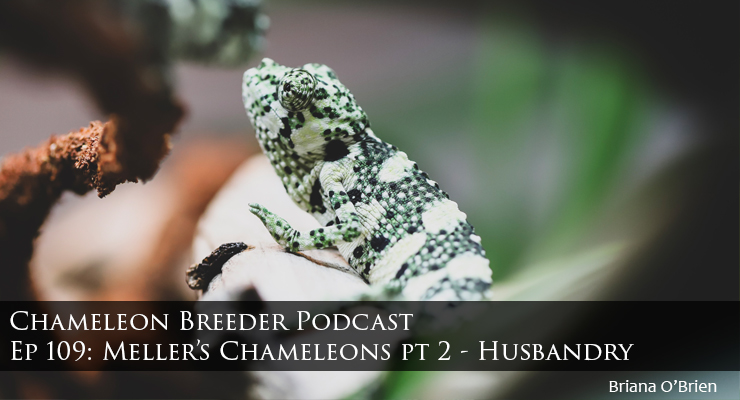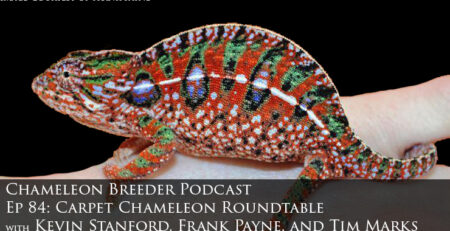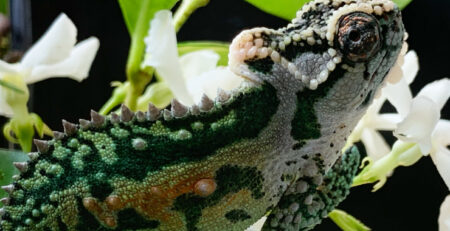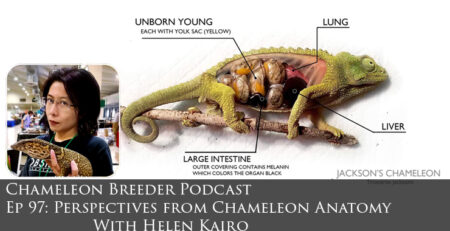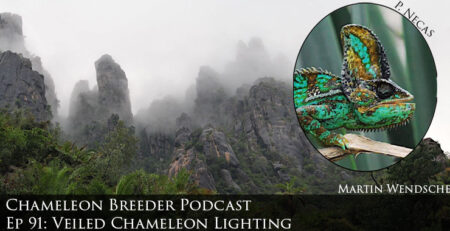Ep 109 Meller’s Chameleons Part 2 – Husbandry
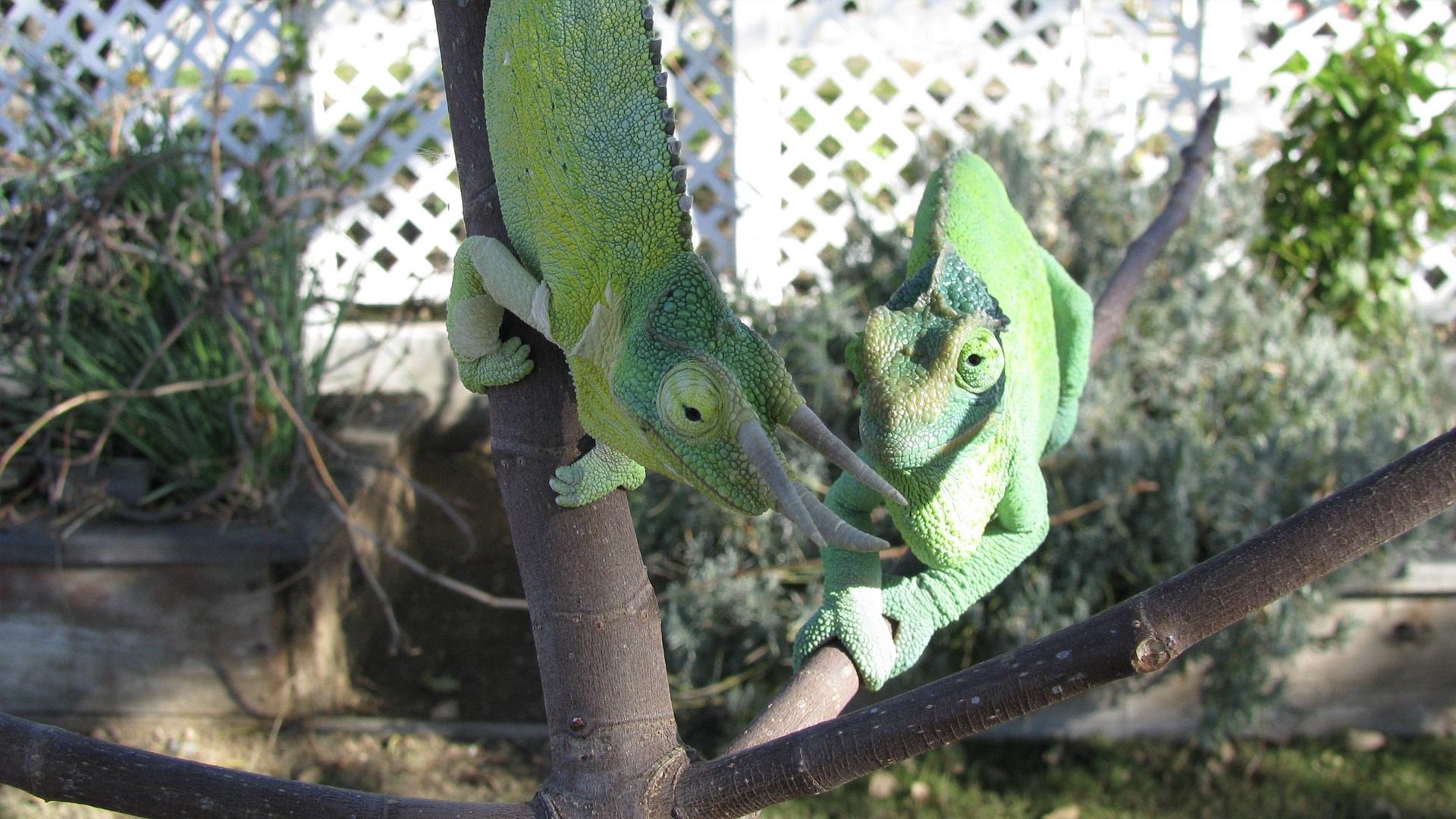
Image courtesy of Briana O’Brien
The Meller’s Chameleon is one of the most impressive of chameleons. Like all chameleons it has certain envrronmental needs that we must meet if we are to keep them siuccessfully. In today’s episode we talk with three breeders of Trioceros melleri and they share, in their own words, how they set up a melleri environment.
Introduction to this Podcast Episode
In the first part of this series we talked about the natural history of Trioceros melleri and the housing strategy. Today we will talk about husbandry. And that is how you set up their cage to replicate the conditions they need as well as nutrition. Our three breeders are back to help us get started in the right direction. Dale Tamura from the United States, Martine Desjardins from Canada, and James Killey from the United Kingdom share their hard won elements of success.
To start off, I’d like to say that much of what we go over is the same husbandry that you would perform for any chameleon. We are going to start at the beginning so we are comprehensive. But it won’t be long before some of you who have been around for a bit will start thinking that this care information sounds suspiciously similar to the care information I share about just about any other chameleon species. And that is because Meller’s Chameleons are….chameleons. Just like most other chameleons, once you dial in the basics the difference between species is just some subtle shifts. Tweak day time humidity and set the right night and day temperature levels and figure the appropriate UVB levels you’ve taken care of the bulk of the species available to us. That said, we are going to start at the beginning and work our way forward.
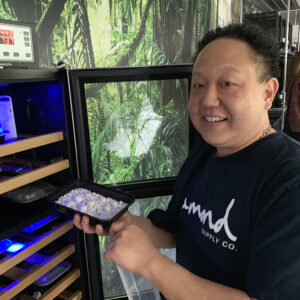
Dale Tamura lives in California, USA.
Dale had an interesting introduction to chameleons as he started with a Meller’s Chameleon given to him as a gift from his family. He fell in love with this chameleon and dedicated himself to providing for him and other melleri that would soon join. Dale currently maintains a colony of these magnificent chameleons at his business where he houses them in museum-like display cages which sets the bar as to what a chameleon set-up can look like.
In 2018, Dale produced his first captive hatched babies and repeated the success in 2019. He has unrelated bloodlines and is continuing his momentum towards the goal of producing a generation of F2 Meller’s Chameleons.
If you are interested in inquiring about becoming a new Melleri home you may contact Dale on his Facebook page at Dale Tamura Facebook

Martine Desjardins lives in Quebec, Canada.
Martine got her start with reptiles while babysitting an iguana. It wasn’t until she met a chameleon that she knew she had found her calling. After a heartbreaking start attempting to rehabilitate an imported Meller’s Chameleon she vowed to make captive hatched babies available to her home country of Canada.
Martine has refined the concept of the free range set-up to match the needs of the Meller’s Chameleon. Though she recommends against doing a group in a free range like she does (due to cost, time, and skill to maintain it properly) we can learn a tremendous amount from her experiences.
If you are in Canada and are interested in continuing the effort to establish Trioveros melleri there then you may contact Martine at Martine on Facebook

James Killey lives in the United Kingdom.
James has been a long time chameleon breeder and restarted his work with Trioceros melleri when his girlfriend brought home a pair to surprise him. James started them off as a pair in a large cage, but then went with his gut instinct that things could be better. After separating them he was able to get strong mating behavior which resulted in successful reproduction.
James works with the Rothwell Pets and Reptiles store in Rothwell, UK, though he mentions that he is picky about who he sells a chameleon to and the average pet store customer is not a suitable candidate. His chameleon customers are generally by personal contacts and the Hamm show.
If you would like to contact James then you may do so at James on Facebook
Dale Tamura's Cage Banks

Dale Tamura creates museum quality caging and keeps one chameleon per cage.
Martine's Free Range

The reason why Martine’s free range works is that it is large enough to give every inhabitant a separate areas with basking lights and regular watering. With nothing to lack there is no reason to wander.
There is also a great deal of space between territories allowing the inhabitants to feel secure.

